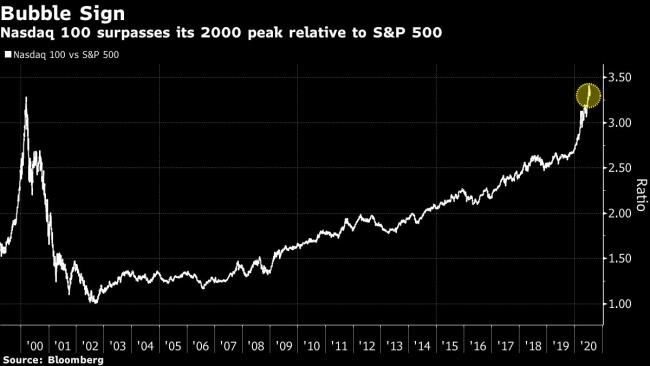(Bloomberg) -- Just three days after the Nasdaq 100’s biggest rally since April, those gains are history, and warnings are getting louder that tech stocks are in a bubble.
Fifty-year Wall Street veteran Ned Davis added his venerable voice to the chorus of worriers, citing the speed of the index’s advance -- before today -- and surging share volume. The Nasdaq 100 was down 2.8% Thursday, wiping out its gain for the week.
Of particular concern to bulls were plunges in Microsoft Corp (NASDAQ:MSFT). and Tesla (NASDAQ:TSLA) Inc., right after reporting earnings that exceeded analyst forecasts. The very biggest internet and software companies, collected under the Fang umbrella, have now fallen in six of the last nine sessions, losing 4.6% over that span for their worst run since March.
“The Nasdaq 100 looks bubbly to me,” Davis wrote in a note to clients of Ned Davis Research. “If this isn’t a sign of climbing up a high diving board for speculation, I don’t know what is.”
He plotted the velocity of the advance against the S&P 500 and found the price ratio has exceeded the peak seen during the dot-com era in 2000. Similarly, trading among all stocks listed on Nasdaq has jumped to a record relative to those on the New York Stock Exchange as investors embraced speculative names.
The drumbeat for such warnings has picked up in recent months as the S&P 500 has come close to erasing its bear-market decline, bouncing back even as a recession and pandemic rage. That rally has nothing on the Nasdaq 100, which, driven by internet and software companies seen benefiting from social distancing, has surged more than 50% from its March bottom, sending its price-earnings ratio to the highest level in two decades.
Read: Tech’s Perfect Profit Record Fails to Impress Spoiled Bulls
As dangerous as it all seems, market watchers like Canaccord Genuity LLC strategist Tony Dwyer are quick to point out some key differences now versus 2000. Back then, the Federal Reserve was tightening monetary policy, with its benchmark interest rates rising to 6.5%. Now, the central bank has cut rates to near zero and says it remains willing to combat the effects of the virus on the U.S. economy.
Also supporting the current rally is a wider market participation, according to Dwyer. While it’s true that tech megacaps have dominated equity gains, other companies haven’t been completely left out. The cumulative advance-decline line for stocks listed on the NYSE, which represents the number of daily gains minus the number of daily declines, is hovering near an all-time high. By contrast, in 2000, market breadth had weakened for two years.
“While many fear the current environment is like 2000 ‘dot com’ bubble, the macro backdrop suggests otherwise,” Dwyer said. “The very different macro backdrop vs. 1999 suggest any pullbacks should prove temporary.”
Still, tech’s market dominance has raised some eyebrows. Should Facebook Inc (NASDAQ:FB)., Amazon.com Inc (NASDAQ:AMZN). and Google’s parent Alphabet (NASDAQ:GOOGL) Inc. be categorized as technology in the S&P 500, rather than communications or consumer discretionary where they currently belong, the tech industry’s index representation would have increased by roughly 10 percentage points to 37.5%, according to DataTrek Research. That’d exceed the industry’s peak weight of 32.5% during the internet bubble.
That big of a share would not only be the largest for technology itself, it would also exceed all other sectors since at least 1980. The closest industry peak weight, DataTrek found, was 29% from energy in December 1980.
“If prosaic oil companies were once 29% of the S&P, why can’t innovative tech one day be 50% of the index?” DataTrek’s Co-founder Nicholas Colas wrote in a note. “Yes, at that point I think we’d all agree tech would be in a bubble just like energy was in 1980. But we’re not there yet.”
©2020 Bloomberg L.P.

